Contents
Tomatoes are grown by gardeners around the world. Their tasty fruits are considered berries in botany, and cooks and farmers have long been called vegetables. The culture belongs to the genus of nightshade plants. Her closest relatives in the garden are potatoes, eggplants and peppers. Depending on the variety, the tomato bush can have a height of 30 cm to 3 m. The fruits of the culture also differ in a variety of colors and weights. Some large-fruited varieties can bear fruit weighing up to 1 kg. The composition of the mature product includes a lot of useful substances, vitamins, minerals, acids and sugars. It is generally accepted that tomatoes have a healing effect: they lower cholesterol levels, increase human immunity. Farmers in Our Country practice growing tomatoes in protected greenhouse conditions and on open ground. Below in the article you can find out some secrets of growing tomatoes and detailed information on how to get a high yield of tasty and healthy vegetables in your area.
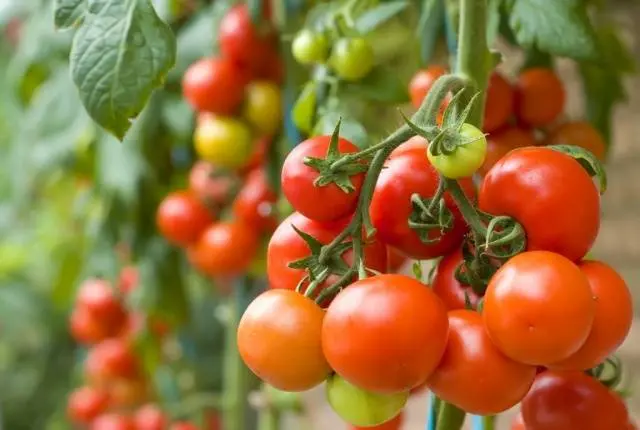
Variety selection: what to look for
Experienced farmers probably have a few favorite, proven varieties of tomato that they grow annually in their garden. For beginner farmers, the choice of variety can cause some difficulties, since each of them has a specific characteristic according to a number of criteria:
- Tall stature. This is the first criterion that you need to pay attention to when buying seeds for growing tomatoes. There are indeterminate, determinant and standard varieties. Feature of indeterminate tomatoes consists in unlimited growth of shoots. Such bushes are called tall and are often grown in greenhouses, which allows you to harvest until late autumn. When growing indeterminate tomatoes, special attention should be paid to top dressing and the formation of bushes. Medium-sized tomatoes are called determinant, which independently complete their growth after the appearance of a certain number of fruit brushes. Their yield is somewhat lower than that of indeterminate tomatoes, but cultivation requires less attention and care. Standard low-growing varieties do not require the formation of bushes and are considered tomatoes for lazy gardeners.
- fruit ripening period. The first tomatoes at the beginning of summer are the most desirable. They can be obtained by growing early-ripening varieties that bear fruit already 85 days after seed germination. Mid-early types of tomatoes ripen after 100 days, but it will take more than 120 days to wait for ripe fruits of late varieties.
- Productivity. This characteristic is fundamental for many farmers. The most high-yielding are indeterminate tomatoes, which allow you to get up to 50 kg / m2.
- Resistance to low temperatures and diseases. This criterion is very important when growing tomatoes in the northern regions.
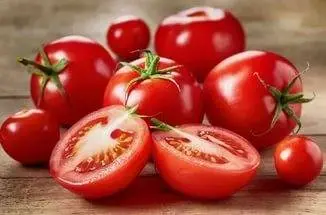
In addition to the main characteristics, the taste of vegetables, their average weight, shape, color, and tomato hybridity are of particular importance. It is worth noting that you can prepare your own seeds for the next year only from varietal tomatoes. The quality of hybrids with self-harvesting of grains is lost.
Preparation of seeds for sowing
Many farmers are sure that the secrets of growing tomatoes lie in the proper preparation of seeds for sowing. With the help of some procedures, even before sowing the grains in the ground, it is possible to influence the quality and viability of adult tomatoes. So, the correct preparation of seeds for sowing consists of several important steps:
- Warming up. This procedure allows you to make tomatoes more resistant to summer drought. For its implementation, the seeds are placed in a cloth bag and suspended from a hot battery for a month.
- Hardening. Hardening tomato seeds means making future tomatoes adapted to adverse weather conditions, short-term cold snaps. The procedure is important when growing tomatoes in unprotected soil. For hardening, the seeds are laid out on a damp cloth and placed in the refrigerator for 12 hours. After that, the seeds are warmed at room conditions for 6-8 hours. The cycle is repeated for 5-7 days.
- Etching. On the surface of the seeds, there may be harmful microflora in the form of bacteria and fungi, as well as pest larvae. They can be removed by dressing the seeds with a 1% manganese solution. The grains are soaked for 30-40 minutes, after which they are washed with clean running water.
- Selection. Sowing a large number of tomato seeds requires a lot of time, effort and free space. Only high-quality, viable seeds for sowing can be selected using saline. In a half-liter jar of water, it is necessary to dissolve a tablespoon of salt and place tomato seeds in the solution, mixing the liquid again. After 10 minutes, the filled tomato seeds will sink to the bottom of the container, and the empty ones will remain floating on the surface of the liquid. They need to be removed. Seeds selected for sowing should be washed with clean water.
- Soaking in nutrient solution. There are many different drugs that activate the growth of tomato and accelerate the germination of seeds, increase the immunity of the plant. One of these drugs is “Epin”. 2 drops of this substance are added to 100 ml of water and tomato seeds are soaked for 2 hours.
- Germination. For seedlings, it is recommended to sow already germinated tomato seeds. You can germinate them in a damp tissue at a temperature of + 22- + 250C. Water during soaking can be replaced with aloe juice, which will have a disinfecting effect.
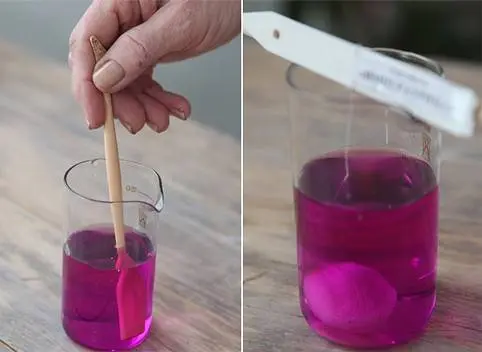
Processed, germinated seeds are the guarantor of high germination of tomatoes. All of these procedures strengthen the immunity of tomatoes, make them more viable and strong, and increase crop yields.
We grow seedlings correctly
Strong seedlings are the key to a good harvest of tomatoes. It can be grown only with proper care, timely watering and feeding of young plants.

Time to sow
It is recommended to plant the grown seedlings of tomatoes at the age of 40-45 days. Taking into account the climatic features of the growing region and the precocity of the variety, it is necessary to calculate the optimal date for sowing seeds for seedlings.
In greenhouse conditions, tomato seedlings can be planted in mid-May, which means that you need to sow tomato seeds at the end of March. Tomato seeds with a long fruit ripening period are sown for seedlings very early, starting in February. Such tomatoes are planted in the soil at the age of 60-70 days.
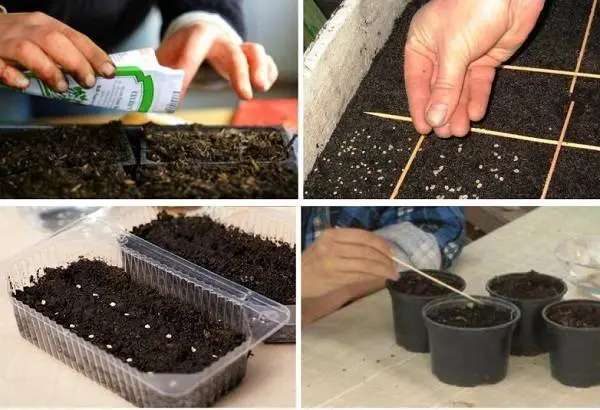
Optimal conditions for seedlings
Grow tomato seedlings in small containers with holes in the bottom to drain excess water. The height of the container must be at least 10 cm. It must be filled with nutrient soil. The substrate can be purchased at the store or prepared with your own hands by adding peat and sand to the ground from the garden. You can improve the nutritional value of the soil for tomatoes with the help of wood ash and mineral fertilizers. The rate of their application is: for a bucket of substrate 500 ml of ash and 2 tbsp. l. superphosphate.
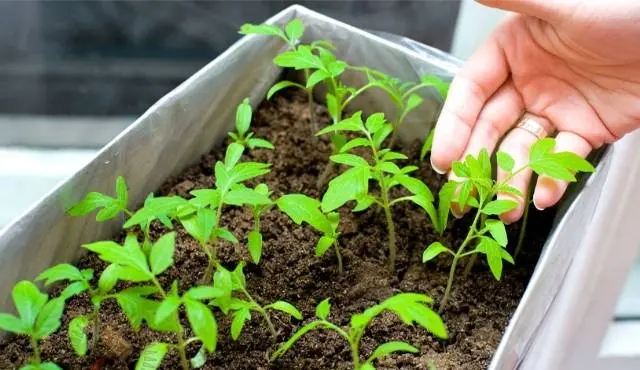
Before sowing the seeds, the soil in the container is slightly compacted and the tomato seeds are planted to a depth of 3-4 mm. Water the soil with tomato plantings very carefully so as not to wash the seeds to the surface of the soil. After sowing, the container is covered with a film and placed in a warm place. After germinating tomato seeds, the shelter is removed from the container and placed in a well-lit place with a temperature of +20-+220C.
The technology for growing tomato seedlings provides for the presence of light for 12-14 hours daily. In the spring, such lighting can only be obtained by highlighting tomato seedlings with fluorescent lamps.
This will avoid intermediate dive seedlings in the process of growing tomatoes.
Caring for young tomatoes
Tomato seedlings need to be watered 1-2 times a week. As the plants grow, watering becomes more frequent, preventing the soil from drying out. It must be remembered that excessive watering of tomatoes leads to the development of fungal diseases.

With the advent of the first true leaflet, tomato seedlings from a common container should be dived into separate containers. To do this, you can use peat pots, plastic cups or small plastic bags. The composition of the soil for filling containers should be similar to that in which tomatoes previously grew.
1,5 weeks after the pick, the tomatoes must be fed. To do this, 5 g of ammonium nitrate, 40 g of simple superphosphate and 12 g of potassium sulfate are poured into a bucket of water. Such a composition of the fertilizer will allow the tomatoes to take root well, quickly increase the green mass. Further feeding schedule depends on the condition of the plants. According to the cultivation technology, it is recommended to fertilize tomato seedlings 3-4 times during the entire growing period.

Organic matter can also be used to feed tomato seedlings. It can be, for example, mullein infusion (1 liter per 10 liters of water). You can make such an organic fertilizer complex by adding wood ash (1st per 10 liters of solution). Ash can be replaced with superphosphate in the amount of 25 g.
Tomato seedlings 10 days before planting in the soil must be fed with potassium phosphate fertilizer. To do this, add 70 g of potassium sulfate and superphosphate in the amount of 40 g to a bucket of water.
Hardening
2 weeks before planting seedlings in the soil, tomatoes begin to harden. To do this, first, the windows are regularly opened in the room to slightly reduce the temperature. In the future, tomato seedlings are taken out into the street, first for 15 minutes, then gradually increase the time the plants stay in unprotected conditions until full daylight hours. Such hardening will prepare the tomatoes for exposure to direct sunlight and atmospheric temperature changes. Hardening adapts tomatoes to new growing conditions, which reduces the stress of tomatoes after planting in the ground.
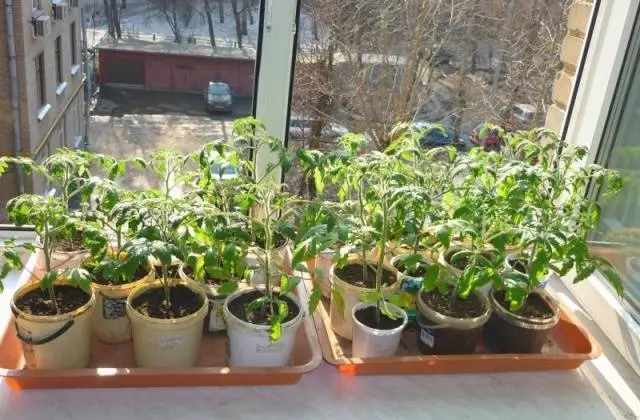
As a result of proper cultivation of seedlings, by the time they are planted in the ground, tomatoes should look strong and healthy. On the main stem up to 25 cm high, there should be about 6-9 true leaves. The thickness of the stem largely depends on the tallness of the variety and can be 4-6 mm. The presence of 1-2 flower clusters is also the norm for good tomato seedlings.
Planting seedlings in the ground
Tomatoes are heat-loving plants that need to be grown in sunny, windless areas of the earth. Forerunners for tomatoes can be cucumbers, root crops, onions, dill.
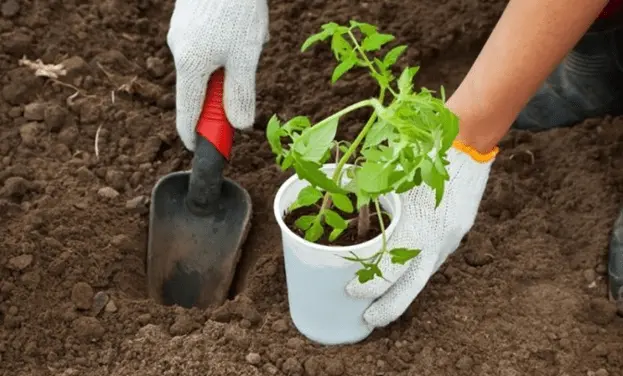
Tomato seedlings can be planted only on previously prepared soil. To do this, in the fall, the remains of vegetation are removed from the site and the soil is dug up with manure. The consumption of fresh organic fertilizer for growing tomatoes can be 4-6 kg/m2. If it is not possible to prepare the soil in the fall, organic matter can be added to the soil in the spring, but it should be borne in mind that it must be well rotted. You can replace manure and humus with nitrogen-containing fertilizers, for example, urea (50 g / m2).
Also in the spring, for growing tomatoes, additional potash and phosphorus fertilizers are added to the soil: superphosphate (40-60 g / m2) and potassium nitrate (30 g/m2). Fertilizers can be scattered around the entire perimeter of the site, followed by raking or directly into the holes before planting tomato seedlings.
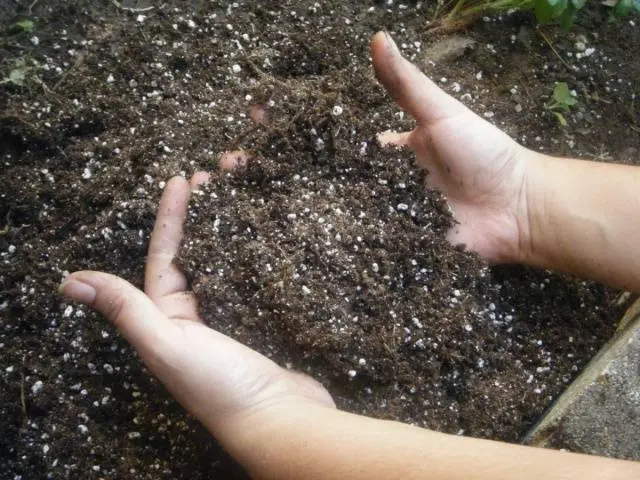
Agrotechnics for growing tomatoes involves strict observance of the distances between the bushes in the garden, since heavily thickened plantings of tomatoes can contribute to the development of various fungal and viral diseases. It is recommended to plant seedlings of tomatoes on beds 1,5 m wide in two rows. The distances between rows on one bed should be at least 60 cm. In each row, the distances between tomatoes depend on the height of the bushes and can be 25-60 cm. ridges in the process of caring for tomatoes.
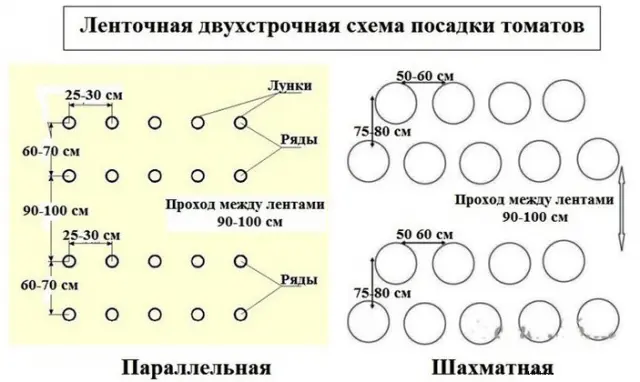
Tomato seedlings should be planted in pre-moistened holes, to a depth of cotyledon leaves in the evening or during the day in cloudy weather. A few hours before planting, tomato seedlings also need to be watered so that at the moment when you need to get the plants out of the container, the clod of earth on the vine does not crumble. After placing the seedlings of tomatoes in the hole, the free space must be covered with earth and squeezed, then pour the tomatoes with warm water. Mulch should be laid on top of wet soil or sprinkled with a dry substrate.
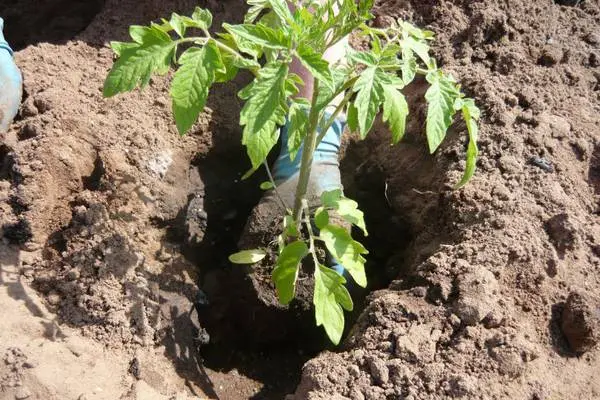
Such a deepening will allow the tomatoes on the lower part of the trunk to build up a rich root system, which will supply the tomatoes with nutrients.
It should be noted that the normal growth and development of tomatoes is observed in conditions with temperatures above +100C, therefore, in relatively cold weather, tomatoes in the open field are covered with a film after planting.
Some other rules for planting seedlings in the ground can be found in the video:
Care of mature plants
Growing tomatoes is a rather painstaking task. With a lack of watering or top dressing, improper formation of bushes, tomatoes immediately begin to mope, and it is not so easy to eliminate an already developing ailment. Therefore, it is very important to care for and grow tomatoes in compliance with some important rules.
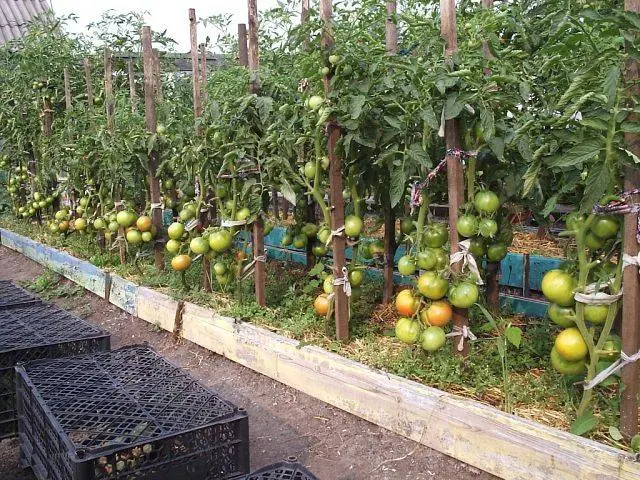
Watering
Tomatoes need to be watered rarely, but plentifully. This basic rule for growing tomatoes avoids the problems associated with parasitizing the fungus. Water the tomatoes in the afternoon or evening. Adult bushes of tomatoes in hot weather are watered every other day. Water consumption depends on the height of the plant: for young tomatoes, 1 liter of water is enough in each well, as they grow, and especially at the stage of formation and ripening of tomatoes, the bushes are watered at the rate of 10 liters per bush.
When watering, water is poured under the tomato root gradually so that it does not spread, but penetrates deep into the earth, nourishing the deeply located root system of tomatoes. Watering tomatoes through a plastic bottle is effective, as shown in the photo:

Loosening
Heavy, wet soil can contribute to tomato root rot during the growing process. You can prevent the development of rotting by loosening the soil. It is necessary to loosen and weed the soil not only in the near-stem circle of tomatoes, but throughout the entire area of uXNUMXbuXNUMXbthe ridge. This will saturate the soil with oxygen and allow the tomato root system to develop harmoniously.
Important is the weeding of ridges with tomatoes. Weeds often attract pests, which over time transfer their colonies to tomatoes, damaging their juicy greens.
Additional fertilizing
It is necessary to feed tomatoes regularly during the growing process, however, you need to clearly know what tomatoes like, what fertilizers to use for them during what growing season. So, at an early stage of growing tomatoes, it is necessary to feed fertilizers with a high nitrogen content. This will allow them to quickly increase the required amount of greenery. As soon as the first leaves appear on the tomatoes, it is necessary to reorient to potassium-phosphorus top dressing. They are also used until the end of the period of growing tomatoes. Organic and mineral substances can be used as fertilizer.
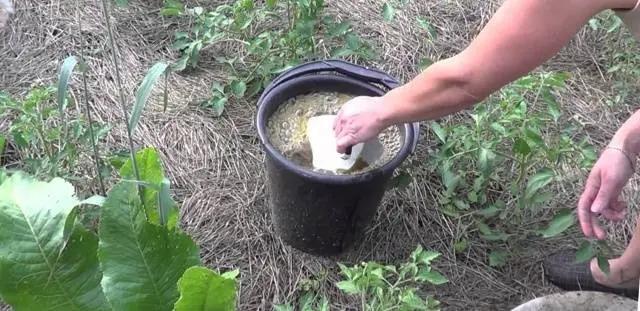
The most affordable organic fertilizer for tomatoes is mullein. It is not used fresh, but is used to prepare an infusion, mixing the fertilizer with water 1: 1. After infusion for 7-10 days, the fertilizer is re-diluted with water 1:10 and used for watering tomatoes. In the mullein infusion, you can add wood ash (1st per bucket of solution), phosphorus or potash fertilizer (30-40 g per bucket of the finished solution). A good organic top dressing for tomatoes is also an infusion of grass.
Often, experienced gardeners when growing tomatoes use fertilizer from yeast or bread crusts to feed.
An example of the preparation of such a tool can be seen in the video:
On sale you can find a lot of different mineral complex and simple fertilizers for tomatoes. The advantage of complex fertilizers is a well-composed dosage of all the necessary substances. The preparation of complex fertilizer for growing tomatoes on their own from simple minerals often causes difficulty for the gardener, since an excess of one or another substance in top dressing can adversely affect tomato growth. The table below shows the recommended dosages of mineral and organic substances depending on the stage of growing tomatoes.

Shrub formation
When growing tomatoes, the formation of bushes is a necessary measure. It consists of several basic operations:
- Pasynkovanie. The procedure involves the complete or partial removal of tomato lateral shoots that form in the axils of the leaves. Stepchildren are removed after their length exceeds 5 cm, leaving a small stump on the tomato trunk.
- Topping. Pinching the main trunk of a tomato is carried out about a month before the expected end of fruiting. In some cases, they also practice pinching lateral stepchildren after fruit brushes and ovaries form on them. During the procedure, pinch off or cut off the upper brush of the shoot, leaving 2-3 full-fledged, healthy leaves that will lift nutrients from the root upwards of the tomato.
- Removing leaves. In the process of growing tomatoes, it is necessary to periodically remove the lower leaves on the bush under the extreme fruit brush. The procedure is carried out 1 time in 2 weeks, removing 1-3 sheets.
- Removing blooming brushes. The first flowering brushes on tomatoes take a very long time to develop and consume a lot of energy. By removing them, you can speed up the process of the formation of new fruit clusters and the ripening of fruits higher up the trunk of the tomato.
The formation of tomatoes in the greenhouse and in open areas of the soil is carried out in the same way, while the process directly depends on the type of bush. For indeterminate tomatoes, all of the above operations are used. Determinate tomato bushes, when grown, stepchild only partially, leaving several fruit-bearing lateral shoots. Standard tomatoes are formed only by removing some stepsons and lower leaves.
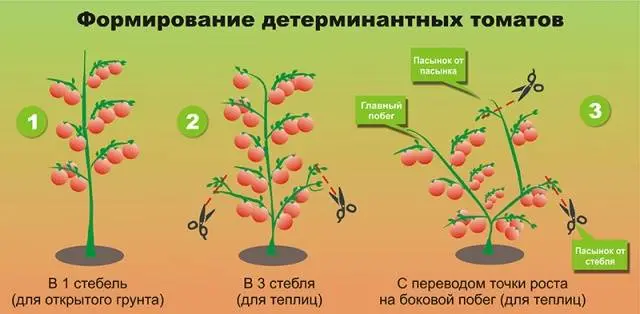
The procedure for the formation of tomatoes must be carried out in the morning of a sunny day, so that the wounds dry out by evening. Otherwise, the tomato can become infected with bacterial, viral or fungal diseases through damaged areas of the skin. The formation of tomatoes is carried out simultaneously with the garter of bushes. Particular attention should be paid to the formation of tomatoes when grown in a greenhouse, where there is practically no natural air circulation.
On the video you can see an example of how to properly form tomatoes with a different type of bush:
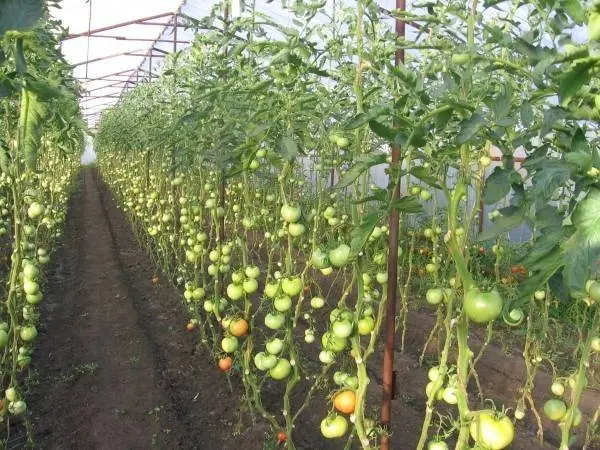
Protection against pests and diseases
Protecting tomatoes from diseases and pests consists, first of all, in proper care of tomatoes and maintaining their high immunity. There are also some universal rules that will help protect tomatoes from pests and diseases during the growing process:
- It is impossible to grow tomatoes near potatoes and other nightshade plants, as this can contribute to the rapid spread of diseases and pests from one crop to another;
- Compliance with the recommended distances between tomatoes will prevent the spread of diseases when one tomato bush is infected;
- Timely and correct formation of tomatoes improves air circulation and prevents the development of putrefactive diseases;
- Growing some plants in tomato beds will help repel insect pests. For example, marigolds repel aphids, mole crickets and scoops with their smell, coriander will eliminate aphids and the Colorado potato beetle. You need to grow helper plants between the rows and along the edge of the ridges with tomatoes.
- Means such as “Epin” can increase the immunity of tomatoes, making them more resistant to various ailments.
- The development of fungal diseases on tomatoes is facilitated by weather with high humidity and sudden changes in temperature. When observing such growing weather conditions, it is necessary to spray the tomatoes with whey, garlic infusion or brine for preventive purposes. Such measures will not allow spores of the fungus to penetrate into the stem of the tomato and damage it. Folk ways to protect tomatoes are characterized by high efficiency and environmental safety.
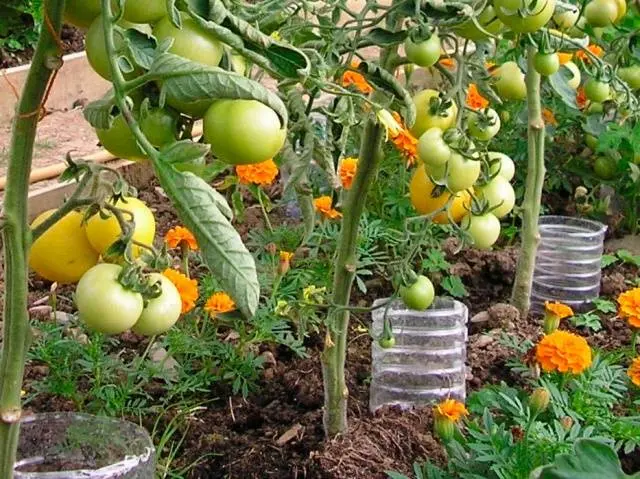
It is not at all difficult to observe the above protection measures when growing tomatoes, while they will prevent the development of diseases and will not allow pests to cause significant damage to plants and crops.

The video clip, the link of which is located below, demonstrates the cultivation of tomatoes in full. After viewing it, you can clearly see all the stages of growing tomatoes and learn some secrets of an experienced farmer:
Conclusion
At first glance, it may seem that growing tomatoes is a very complex process that only selected gardeners can master. In fact, every gardener can get a crop of tomatoes, for this you only need to stock up on certain knowledge. So, by properly preparing and planting tomato seeds in a timely manner, you can get strong, healthy seedlings. It is possible to accelerate its growth and improve the quality of planting material with the help of top dressing. There should be at least three of them until the tomatoes are planted in the ground. Further care for tomatoes involves, first of all, watering and feeding. Conscientious gardeners carry out loosening and weeding regularly for all crops, so the procedure should not cause any particular difficulties. Forming bushes for a novice farmer, of course, can be difficult, but for the correct implementation of the operation, it is necessary, before removing the vegetative organs of the plant, to decide on the scheme for the formation of a tomato. In general, literacy and the correctness of growing a crop comes with experience, because experienced farmers perform all of the above operations without hesitation.









